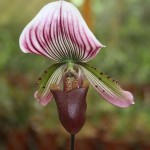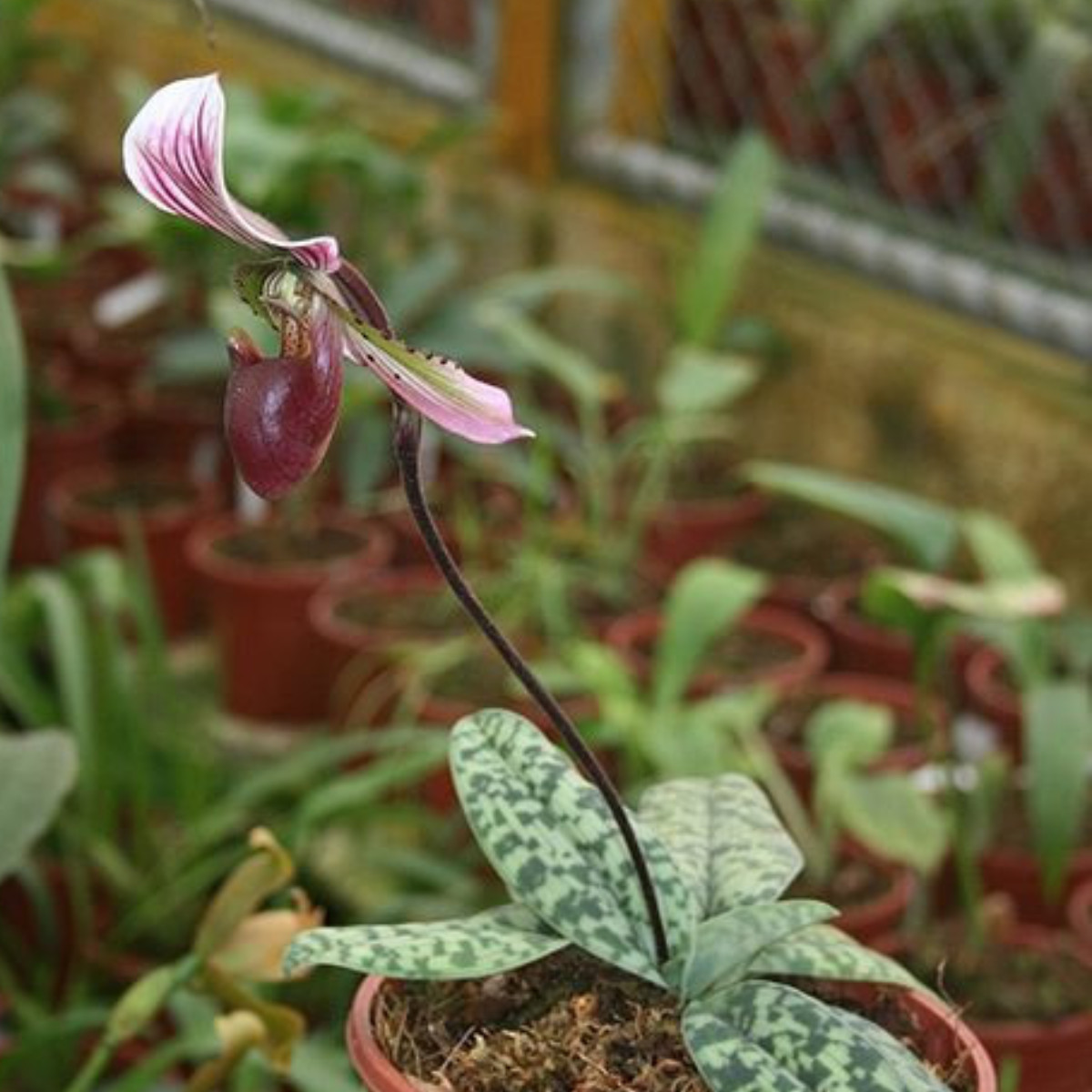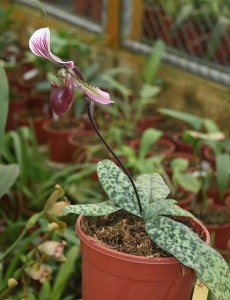Family: Orchidaceae
Synonimous: Cypripedium callosum
Cordula callosa
Cypripedium crossii
Cypripedium schmidtianum
Paphiopedilum crossii
Distribution and habitat: Paphiopedilum callosum are native to Cambodia, Laos, Malaya, Myanmar, Thailand and Vietnam.Paphiopedilum callosum species are terrestrial in nature, growing among humus layers under the shaded and moist condition of thetropical forest floor. They are originating in evergreen broad-leafed forests in the lowlands or in cloud forests in the highlands, altitudes from 300 to 2000m (1000-6500 feet). The plants grow in stages. As new growths mature, older growths will slowly die off. A new growth will bloom when it is fully mature, producing a raceme (bloom spike) between the stiff fleshy leaves. Blooms with heavy substance can often last several months.
Description: Paphiopedilum callosum has leaves up to 30cm (12 inch) long and 5cm (2 inch) wide. Leaf colour is dark green mottled with bright green. The 45cm (18 inch) long flower stem carries one or two 8-10cm (3-4 inch) wide flowers. The dorsal sepal and petals are white with purple and green stripes. The petals curl downward and have hairy, black, raised spots along the top edge. The lip of flower is reddish purple. The shinny, waxy, unreal-looking flower can appear at anytime.
The main flowering season in generally mid-spring. Paphiopedilum callosumsend out one flower spike on each new growth, so when flowering is done, new growth have to mature before will flower again. The flowers should generally last for several weeks up to several months in ideal conditions.
Houseplant care: The key to successfully growing Paphiopedilum callosum is to keep them in conditions that resemble their natural culture: indirect light, a bark based growing medium, light fertilisation and appropriate watering (water thoroughly then let it dry out every 5-7 days).
On a young plant that is flowering for the first time, is recommended to let the flower on for short period and then cut it off. It will keep in a vase for a while and the young plant will grow much better without having to support a bloom. If it is intended to put a seed-pod on Paphiopedilum callosum, chose a strong plant which will be able to hold the pod for the required ten months (this time period applies to Paphiopedilum seed pods). It is an enormous strain on any orchid to grow seeds and only a strong plant will survive.
When cut the Paphiopedilum callosum flower and keep it in a vase, cut the stem flower as long as possible and make a 45 angle cut to increase the water absorption surface. Change the vase water daily and keep cutting a centimetre (0.4 inch) or so every day to avoid sealing the cut and allow the flower to take the needed water to stay fresh. Keep the vase in a relatively cool room (around 21C - 70F) to increase the flower lifespan.
Light: Always grow Paphiopedilum callosum in medium light. Never expose them to any direct sunlight. Supplementary fluorescent light provided from late autumn into early spring will help to promote good flowering.
Temperature: Normal room temperature are generally suitable. A cool summer temperature (not exceeding 30C - 86F) is beneficial and a winter temperature of not less than 13C (55F) is desirable.
For adequate humidity stand the orchids on trays of damp pebbles throughout the year and mist-spray the foliage daily when the temperatures rise above 21C (70F). Paphiopedilum callosum do best with 60-70% humidity but when mature will grow and bloom, although more slowly in lower humidity.
Water: Water moderately during periods of active growth, but allow the top few centimetres (0.8 inch) of the potting mixture to dry out before watering again.
During the six weeks after flowering, when Paphiopedilum callosum make little new growth, water them sparingly allowing the potting mixture to dry out almost completely between waterings.
Fertilising: Apply a foliar feed to Paphiopedilum callosum with every third or fourth watering, except during the six-week period of slow growth.
Potting and repotting: Use a potting mixture of equal parts of fibrous loam, peat moss, chopped sphagnum moss and coarse sand or perlite. Move plants into pots one size larger at the end of the flowering period whenever clumps of leaves completely cover the surface of the potting mixture. Be sure to keep leaf bases level with the top of the mixture; burying them deeper will cause rotting.
After maximum convenient pot size has been reached, propagate Paphiopedilum callosum by division.
Propagation: Divide any Paphiopedilum callosum that has made six or more clumps of leaves. At the end of the flowering season shake away the old potting mixture from the roots, remove any dead roots and carefully cut or pull the rhizome into pieces, making sure each piece has at least two clumps of leaves attached.
Gently disentangle as many of the roots as possible rather than cutting them apart. Plant each piece in an 8cm (3 inch) pot, place it in medium light and mist-spray daily for three weeks. Thereafter, treat it as mature plant.
Problems:
Paphiopedilum callosum roots are easily damaged and are susceptible to rot if overwatered.
Flowers buds sometimes tend to hang downward. To resemble this fault insert a thin stick in the potting mixture and tie the flower stem to it. If the last tie is made just below the bud, flowers open in an upright position.
Failure to flower is typically due to poor growing conditions, especially inadequate light and or fertilizer.
Diseases that are commonly a problem on orchids include leaf spots, petal blight and different fungi such as black rot.
Treatment: Ensure proper air circulation. This will help the orchid heal if it experience a fungal or pest infestation that must be treated. If the problem persists, use an appropriate fungicide.
Common insect pests include mealybugs, spider mites, scales and thrips. Scales are usually attached to the underside of the leaves, and heavily infested plants should be discarded.
Treatment: Physically removing the scales and then controlling the immature stages with chemical sprays may help lightly infested plants. Use an adequate pesticide to combat the insects infestation.
Snails and slugs can feed on buds, blossoms, leaves and tender stems.
Treatment: Use a snail and slugs pesticide to prevent and control them.
Note: Paphiopedilum are notoriously expensive, in part because they do not clone well from tissue culture. As a result, the vast majority of Paphiopedilum plants are started from seed, which requires years to produce a viable plant. Expect to pay top dollar for even a moderate sized Paphiopedilum.
Paphiopedilum callosum are known as maudiae type of Paphiopedilum, orchids characterized by attractive tessellated leaves and smaller flowers.
Uses: Paphiopedilum callosum makes a good orchid to be grown in pot being one of the easiest to grow and flower orchids.
They can be uses as cutting flowers. Paphiopedilum callosum flowers will frequently last surprisingly long times in a vase, maintaining its waxy freshness from 4-6 months.
SUMMARY:
CHARACTERISTICS:
Foliage coloured
Features flowers
Shape upright
Height: 45cm (18 inch)
PROPER CARE:
Watering in rest period sparingly
Watering in active growth period moderately
Light medium
Temperature in rest period min 16C max 24C (61-75F)
Temperature in active growth period min 16C max 24C (61-75F)
Humidity high
Hardiness zone: 10 to 11





